 Australian Capital Territory Numbered Regulations
Australian Capital Territory Numbered Regulations Australian Capital Territory Numbered Regulations
Australian Capital Territory Numbered Regulations(1) A driver at an intersection (except a T-intersection or roundabout) without traffic lights or a stop sign, stop line, give way sign or give way line, must give way in accordance with this section.
Maximum penalty: 20 penalty units.
(2) If the driver is going straight ahead, the driver must give way to any vehicle approaching from the right, unless a stop sign, stop line, give way sign or give way line applies to the driver of the approaching vehicle.
Example 1
Driver going straight ahead giving way to a vehicle on the right that is going straight ahead
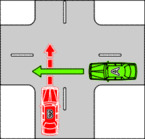
In this example, vehicle B must give way to vehicle A.
Example 2
Driver going straight ahead giving way to a vehicle on the right that is turning right

In this example, vehicle B must give way to vehicle A.
(3) If the driver is turning left (except if the driver is using a slip lane), the driver must give way to—
(a) any vehicle approaching from the right, unless a stop sign, stop line, give way sign or give way line applies to the driver of the approaching vehicle; and
(b) any pedestrian at or near the intersection who is crossing the road the driver is entering.
Example 3
Driver turning left giving way to a vehicle on the right that is going straight ahead
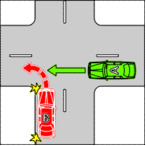
In this example, vehicle B must give way to vehicle A.
Example 4
Driver turning left giving way to a pedestrian on the road the driver is entering
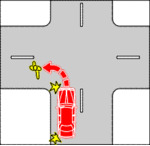
In this example, the vehicle must give way to the pedestrian.
(4) If the driver is turning left using a slip lane, the driver must give way to—
(a) any vehicle approaching from the right or turning right at the intersection into the road the driver is entering (except a vehicle making a U-turn at the intersection); and
(b) any pedestrian on the slip lane.
Example 5
Driver turning left using a slip lane giving way to a vehicle that is turning right into the road the driver is entering
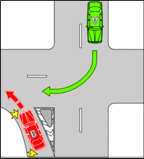
In this example, vehicle B must give way to vehicle A.
(5) If the driver is turning right, the driver must give way to—
(a) any vehicle approaching from the right, unless a stop sign, stop line, give way sign or give way line applies to the driver of the approaching vehicle; and
(b) any oncoming vehicle that is going straight ahead or turning left at the intersection, unless—
(i) a stop sign, stop line, give way sign or give way line applies to the driver of the oncoming vehicle; or
(ii) the oncoming vehicle is turning left using a slip lane; and
(c) any pedestrian at or near the intersection who is crossing the road the driver is entering.
Example 6
Driver turning right giving way to a vehicle on the right that is turning right into the road the driver is leaving
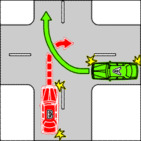
In this example, vehicle B must give way to vehicle A.
Example 7
Driver turning right giving way to an oncoming vehicle that is going straight ahead on the road the driver is leaving
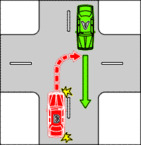
In this example, vehicle B must give way to vehicle A.
Example 8
Driver turning right giving way to an oncoming vehicle that is turning left into the road the driver is entering
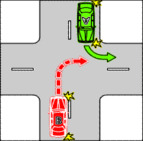
In this example, vehicle B must give way to vehicle A.
Example 9
Driver turning right giving way to a pedestrian on the road the driver is entering
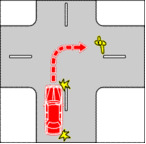
In this example, the vehicle must give way to the pedestrian.